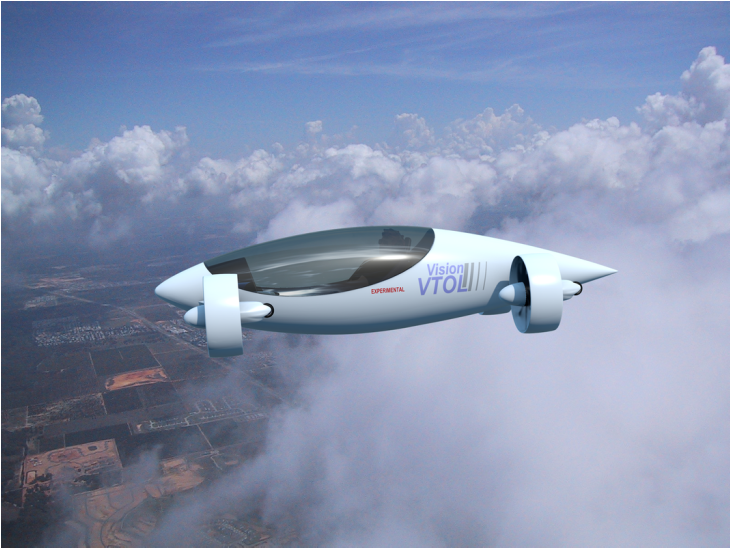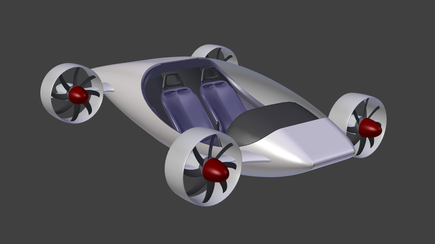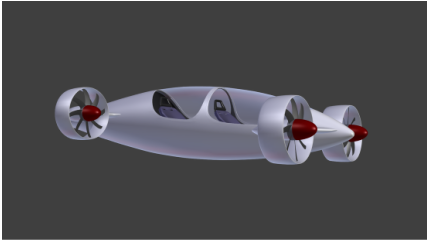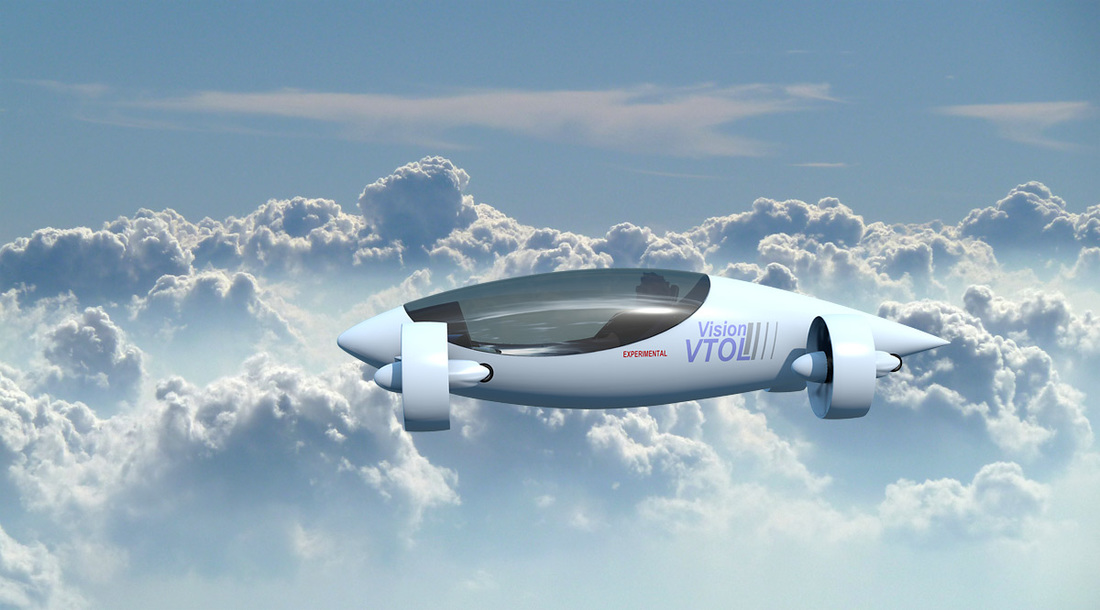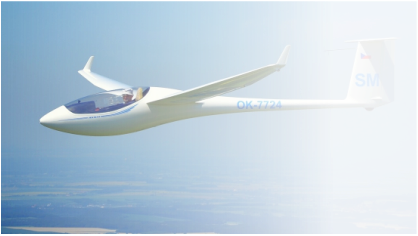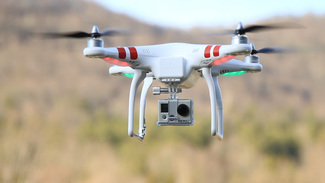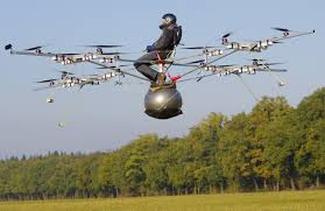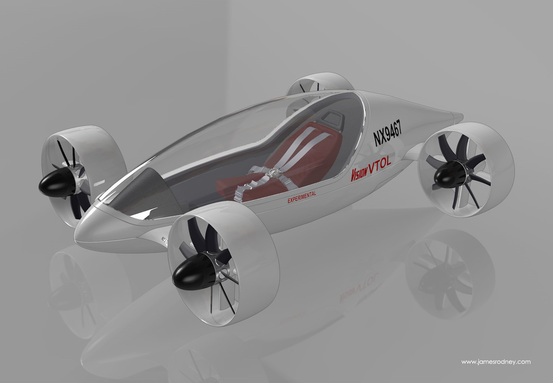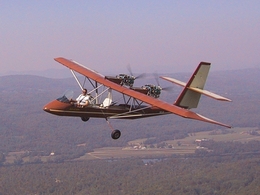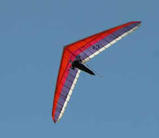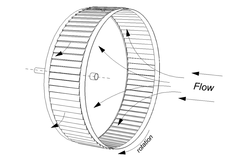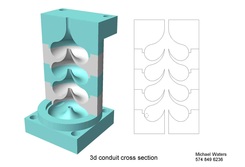© The Waters Trust, 2014, All Rights Reserved
Vision VTOL
The Vision VTOL is designed specifically for the imminent evolution of electric power storage and energy breakthroughs. This is an area that we have been working closely with for years at the cutting edge.
Transportation is about to take a massive leap forward. Current Lithium batteries are the only remaining limit to range and cost of electric vehicles. Electric motors are inevitably more reliable than turbines or piston engines with only one moving part.
At the same time a quiet revolution in aviation has occurred. There are now more quadcopters and multirotors flying than any other type of aircraft. The only reason why full size electric multirotors are not practical yet is because of range.
The simplicity of electric quadcopters is that there is no need for control surfaces, wings, fuel systems or other limitations of conventional aircraft. The electronic controls, software and sensors are the same for a drone, single seat or flying home and already fully developed. This enables a huge advantage over current aviation in safety, cost, reliability and scalability.
At only 4 times current Lithium polymer density, the Vision becomes practical with a 4 hour range. We are working with 30 times current density and storage life expectancy. This allows transcontinental range at high speed and will inevitably make electric aviation by far the most practical form of transportation.
Imagine a car with a 10,000 mile range. Now imagine what that really means. With a similar advance in electric aviation, roads and even airports can become almost obsolete.
The Vision is the beginning of a new breed of transportation that is specifically designed for ultra long range electric power and storage - point to point transportation with unprecedented safety and luxury. First designed over 10 years ago, all technologies required are now fully developed.
Welcome to the future.
Transportation is about to take a massive leap forward. Current Lithium batteries are the only remaining limit to range and cost of electric vehicles. Electric motors are inevitably more reliable than turbines or piston engines with only one moving part.
At the same time a quiet revolution in aviation has occurred. There are now more quadcopters and multirotors flying than any other type of aircraft. The only reason why full size electric multirotors are not practical yet is because of range.
The simplicity of electric quadcopters is that there is no need for control surfaces, wings, fuel systems or other limitations of conventional aircraft. The electronic controls, software and sensors are the same for a drone, single seat or flying home and already fully developed. This enables a huge advantage over current aviation in safety, cost, reliability and scalability.
At only 4 times current Lithium polymer density, the Vision becomes practical with a 4 hour range. We are working with 30 times current density and storage life expectancy. This allows transcontinental range at high speed and will inevitably make electric aviation by far the most practical form of transportation.
Imagine a car with a 10,000 mile range. Now imagine what that really means. With a similar advance in electric aviation, roads and even airports can become almost obsolete.
The Vision is the beginning of a new breed of transportation that is specifically designed for ultra long range electric power and storage - point to point transportation with unprecedented safety and luxury. First designed over 10 years ago, all technologies required are now fully developed.
Welcome to the future.
|
A next generation aircraft platform designed to do what no current aircraft is capable of.
Performance Fully scalable from UAV to large transport Vertical takeoff and landing Stable Fast Highly reliable Long range Electric If you are a pilot this may look radical. Compared to what we are flying today it is. However, it is also designed with the highest safety,reliability and systems redundancy in mind.
There is nothing new here except the source of energy. The Vision is a quadcopter. There are probably more of this type of aircraft flying today than any other form of aircraft and they are extremely easy to fly. Everything required for a full size tilt rotor electric VTOL has already been developed. |

Energy source
The Vision program is more than an aircraft, it is a tool to bring awareness to energy breakthroughs that demonstrate just a little of what the coming era of sustainable energy abundance means for humanity.
There are a number or high density energy storage technologies now either entering the market or close to doing so. Compared to Lithium Polymer, current energy density potential is between 2 and 100 times higher. Energy density equates to range. Double the energy density for the same weight and you double the range. 5X is enough for a practical electric VTOL.
Our primary option ihas an energy density potential of over 20X greater than Lithium Polymer. Initial prototypes already demonstrate a practical range increase of between 4 and 6 times without even optimizing existing manufacturing methods that increase this number significantly.
The following examples show that these advances are not unique or far fetched:
http://www.extremetech.com/computing/153614-new-lithium-ion-battery-design-thats-2000-times-more-powerful-recharges-1000-times-faster
http://newsroom.ucla.edu/releases/ucla-scientists-create-quick-charging-hybrid-supercapacitors
http://www.extremetech.com/extreme/182500-dual-carbon-batteries-is-this-finally-the-breakthrough-weve-been-promised-for-so-long
http://www.greencarreports.com/news/1093530_new-lithium-ion-battery-uses-peroxide-to-boost-energy-density-by-7-times-report
Due to breakthroughs in the last year with graphene for example, actual power densities achieved are many times higher than what is being publicly claimed.
Our primary focus with energy storage is the amazing work of Robert Murray Smith.
https://www.youtube.com/user/RobertMurraySmith/playlists
The battery that Robert has developed has the ability to revolutionize energy storage at any scale due to cost, power density, sustainability, safety and longevity. This technology is now market ready.
Physics
The physics behind technologies we are developing relates to new discoveries in manipulation of matter and energy at the atomic level and energy densities that lie somewhere between chemical and nuclear. This will not make sense to classically trained engineers without an understanding of both atomic resonance and 5th state matter but that is a limitation of knowledge, not capability. The ramifications of this emerging science far exceed energy storage or transportation alone.
A high speed transcontinental range electric aircraft that is inherently simple and more reliable than a helicopter provides a highly practical transportation solution. The Vision program is a scalable electric tiltrotor system, not a single design.
Existing technologies
The Vision was originally designed over a decade ago, waiting for energy breakthroughs to evolve with the energy and power density required to usher in the next evolution in flight. These capabilities have now arrived. A VTOL with this level of performance can be optimized for high speed where very little lift is required. This also reduces effects of turbulence considerably. There are no control surfaces or conventional wings even though the ducted fan shrouds are in fact, highly efficient circular wings. https://en.wikipedia.org/wiki/Channel_wing
The single seat prototype uses a conventional sailplane fuselage with little modification required. A modern sailplane cockpit is one of the most comfortable and streamlined fuselages available in aviation and visibility is excellent. We are using this already produced component approach initially for both 1 and 2 seat versions to reduce development costs.
Here is a recent example of a state of the art electric aircraft powerplant by Seimens. Note the small size of a 250kw powerplant! http://www.gizmag.com/siemens-world-record-electric-motor-aircraft/37048/
Brushless electric motors are statistically far more reliable than turbines and the Vision can sustain a failure of any two without having to deploy a typical general aviation ballistic parachute.
The Vision program is more than an aircraft, it is a tool to bring awareness to energy breakthroughs that demonstrate just a little of what the coming era of sustainable energy abundance means for humanity.
There are a number or high density energy storage technologies now either entering the market or close to doing so. Compared to Lithium Polymer, current energy density potential is between 2 and 100 times higher. Energy density equates to range. Double the energy density for the same weight and you double the range. 5X is enough for a practical electric VTOL.
Our primary option ihas an energy density potential of over 20X greater than Lithium Polymer. Initial prototypes already demonstrate a practical range increase of between 4 and 6 times without even optimizing existing manufacturing methods that increase this number significantly.
The following examples show that these advances are not unique or far fetched:
http://www.extremetech.com/computing/153614-new-lithium-ion-battery-design-thats-2000-times-more-powerful-recharges-1000-times-faster
http://newsroom.ucla.edu/releases/ucla-scientists-create-quick-charging-hybrid-supercapacitors
http://www.extremetech.com/extreme/182500-dual-carbon-batteries-is-this-finally-the-breakthrough-weve-been-promised-for-so-long
http://www.greencarreports.com/news/1093530_new-lithium-ion-battery-uses-peroxide-to-boost-energy-density-by-7-times-report
Due to breakthroughs in the last year with graphene for example, actual power densities achieved are many times higher than what is being publicly claimed.
Our primary focus with energy storage is the amazing work of Robert Murray Smith.
https://www.youtube.com/user/RobertMurraySmith/playlists
The battery that Robert has developed has the ability to revolutionize energy storage at any scale due to cost, power density, sustainability, safety and longevity. This technology is now market ready.
Physics
The physics behind technologies we are developing relates to new discoveries in manipulation of matter and energy at the atomic level and energy densities that lie somewhere between chemical and nuclear. This will not make sense to classically trained engineers without an understanding of both atomic resonance and 5th state matter but that is a limitation of knowledge, not capability. The ramifications of this emerging science far exceed energy storage or transportation alone.
A high speed transcontinental range electric aircraft that is inherently simple and more reliable than a helicopter provides a highly practical transportation solution. The Vision program is a scalable electric tiltrotor system, not a single design.
Existing technologies
The Vision was originally designed over a decade ago, waiting for energy breakthroughs to evolve with the energy and power density required to usher in the next evolution in flight. These capabilities have now arrived. A VTOL with this level of performance can be optimized for high speed where very little lift is required. This also reduces effects of turbulence considerably. There are no control surfaces or conventional wings even though the ducted fan shrouds are in fact, highly efficient circular wings. https://en.wikipedia.org/wiki/Channel_wing
The single seat prototype uses a conventional sailplane fuselage with little modification required. A modern sailplane cockpit is one of the most comfortable and streamlined fuselages available in aviation and visibility is excellent. We are using this already produced component approach initially for both 1 and 2 seat versions to reduce development costs.
Here is a recent example of a state of the art electric aircraft powerplant by Seimens. Note the small size of a 250kw powerplant! http://www.gizmag.com/siemens-world-record-electric-motor-aircraft/37048/
Brushless electric motors are statistically far more reliable than turbines and the Vision can sustain a failure of any two without having to deploy a typical general aviation ballistic parachute.
|
Development
All primary development is done with simulation, virtual reality, video games, RC models, UAV's and stabilized camera platforms. This enables a significant reduction in development cost. We are also open sourcing development since our primary purpose is to support an energy paradigm shift. Open sourcing and encouraging a fun, rewarding global team approach will allow this project to evolve more rapidly, with greater chance of success. |
|
To really understand this craft, realize that with electric motors, size makes little difference. The technology is the same. Properly designed electric motors are also far more reliable than fuel based powerplants.
The same reliable piezo gyros that are in your cell phone provide primary stability, just like any toy quadcopter currently does. Millions of them are flying reliably. There is literally no difference in the technology required at any scale except for the amount of redundancy required for safety. |
|
The only real difference between our design and most existing quadcopters is the tilt function. This allows a much higher cruise speed and greater maneuverability. Tiltrotors are nothing new of course. The difference here is in simplicity, reliability and cost. This is what an electric tiltrotor provides. Modern quadcopters are stable and easy to fly. the Vision shares that same quality as it uses the same technology.
|
|
Since the design is far simpler than current aircraft, component cost is lower also. In production we will make full use of the most advanced custom fabrication technologies to enable maximum scalability and mission flexibility. Since the aerodynamics are far simpler in this kind of craft it allows a much wider customizing capability. One version is even designed to go under water. This is a very different way of looking at aircraft or even transportation design. Since this is initially being developed for model and camera platform markets also, we are developing a fully immersive virtual reality goggle capability.
|
Aviation background
|
Mike Waters has built a number of different types of aircraft and also flown over 200 different aircraft including general aviation, experimental, low wing, high wing, midwing, bushplanes, seaplanes, hang gliders, ultralights, paragliders, microlights, biplanes, aerobatic, taildraggers, trikes, twins, autogyros, helicopters. A competition sailplane pilot for over 12 years.
Additional
|
Details
MCAS (Moldless Composite Aircraft System) with advantages over both aluminum and composite manufacturing. This enables many aircraft wing structures to be lighter, stronger and built in far less time than current aluminum or composite approaches.
|
3D valvular conduit - an improvement of Nicola Tesla's original valvular conduit design, this one way fluidic valve and combustion chamber has many potential applications.. This increases effectiveness by an order of magnitude over the original invention.
Currently co-developing an advanced peripheral jet liquid turbine suitable for both power generation and transportation. |
The Vision VTOL was designed around a number of recent advances in electric energy storage and power density. It was realized that these breakthroughs would enable a long range wingless electric aircraft with vertical takeoff capability, effectively making wings redundant. This results in a significant reduction in complexity and cost while increasing reliability and safety over wings and conventional fuel based power systems.
